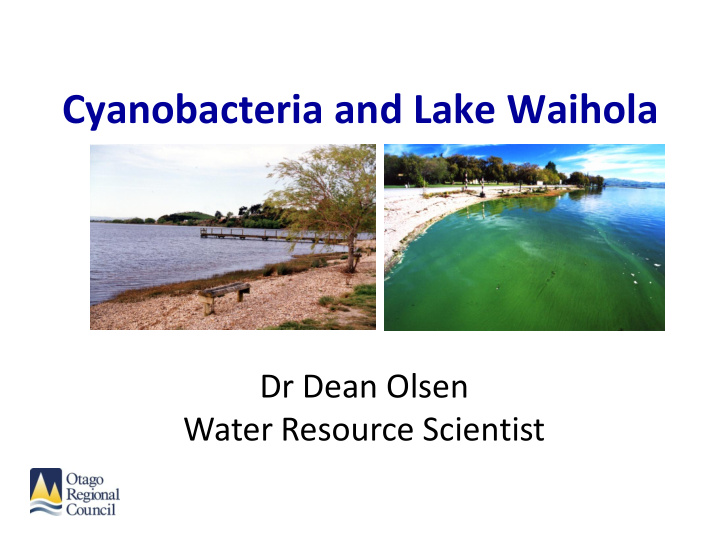



Cyanobacteria and Lake Waihola Dr Dean Olsen Water Resource Scientist
What are cyanobacteria? • Blue-green algae • Photosynthetic bacteria • Found in almost all terrestrial and aquatic habitats
Freshwater cyanobacteria • Planktonic or benthic • Can form dense blooms → water quality issues → Toxins (possible) • Drinking water • Swimming • Animals • Fish • Shallow, eutrophic lakes (but not necessarily)
Blooms & scums • Not a new issue in NZ & widespread Pridmore & Etheredge 1987 • Planktonic cyanobacteria detected in 127 NZ lakes • Conspicuous blooms/scums reported from 33 NZ lakes (including Waihola) Wood et al . (2006) • 37 lakes (incl. Waihola) screened for toxins • Microcystins most abundant class of cyanotoxin in NZ
Dr Susie Wood Cyanobacteria guru
How scums form Wind Very thick scum!
Lake Rotorua, Kaikour
Lake Waihola • Cyanobacteria blooms have occurred previously • E.g. summer 2001/2002 • Anabaena lemmermannii Anabaena planktonica • Microcystin 1.7 µg/L • Drinking water MAV (provisional) : 1 µg/L • Nutrient levels not likely to be limiting algal growth
Not limited to Waihola... Karori Reservoir, Wellington
L. Waahi L. Rotoehu Karori Res. Microcystis sp. Cylindrospermopsis sp. Anabaena sp.
Lake Horowhenua - Levin Microcystis sp.
Cyanotoxins
Cyanotoxins Three broad classes: Hepatotoxins = damage liver Microcystin eg: Microcystis, Anabaena Nodularin eg: Nodularia Cylindrospermopsin eg: Cylindrospermopsis Neurotoxins = affect nervous system Anatoxin-a eg: Aphanizomenon, Anabaena Saxitoxin eg: Lyngba, Anabaena Dermatotoxins = skin irritants Lyngbyatoxin-a eg: Lyngba, Anabaena Aplysiatoxins Lipopolysaccharides eg: most spp.
Microcystins • Globally the most frequently found cyanotoxin • Some cases of human deaths from Microcystis aeruginosa drinking contaminated water • Inhibitors of protein phosphatases enzymes • Liver tumor promoters O O H H COOH COOH • WHO guideline value for DW of N N HN HN NH NH 1µg/L (MC-LR) O O H H H H H H H H O O H H OCH 3 OCH 3 O O NH NH H H X X H H H H NH NH Y Y H H COOH COOH O O
Anatoxin-a & Homoanatoxin-a • Not identified from Waihola O • Neurotoxin H CH 3 N • Rapid death from respiratory arrest • Numerous dog deaths in NZ • Esp. Benthic cyanobacteria in rivers
Dermatotoxins • Severe dermatitis • Burning or itching skin • Red eyes & lips • Asthma symptoms • Sore throat • Dizziness
Safety considerations • Significant health consequences from drinking contaminated water • Humans • Animals (esp. dogs & horses) • Swimming or showering/bathing • Dogs • Contaminated irrigation water can deposit toxins & cells on crops
Take-home messages • Blooms are likely to develop from time to time • Settled, warm weather • Precautions during blooms: • Don’t drink lake water (boiling won’t remove toxins • Including stock water • Minimise contact with water • Keep dogs out of water • Don’t irrigate using lake water during
Bloom detected Sample(s) collected Low High biomass biomass No further Warning signs and ongoing action sampling • No routine monitoring for cyanobacteria in Otago • Rely on public and/or ORC staff to report
Thanks! • A massive thanks to Susie Wood (Cawthron Institute) who provided much of the material for this presentation
Recommend
More recommend